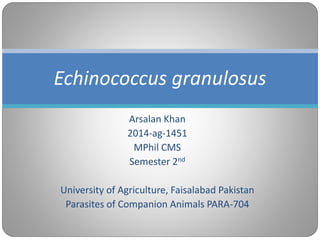
Echinococcus granulosus
- 1. Arsalan Khan 2014-ag-1451 MPhil CMS Semester 2nd University of Agriculture, Faisalabad Pakistan Parasites of Companion Animals PARA-704 Echinococcus granulosus
- 2. Introduction Echinococcus granulosus, also called hydatid worm belongs to class Cestoda It causes cystic echinococcosis in livestock and humans being intermediate hosts and parasitize the small intestines of adult canids It is a zoonotic disease Definitive hosts are carnivorous predators like dogs, wolves, foxes and lions. While sheep, goat, cattle, pigs and rodents are intermediate hosts. Birds and arthropods act as mechanical vectors
- 3. Classification Kingdom : Animalia Phylum : Platyhelminthes Class : Cestoda Sub Class : Eucestoda Order : Cyclophyllidea Family : Taenidae Genus : Echinococcus Species : Echinococcus granulosus
- 4. Morphology The adult tapeworm ranges in length from 2 mm to 7 mm and has three proglottids when intact — an immature proglottid, mature proglottid and a gravid proglottid. It has scolex with four suckers and also has a rostellum with hooks. Echinococcus is triploblastic, anus is absent and it has no digestive system. Its body is covered by tegument and the worm is divided into a scolex, a short neck, and three to six proglottids. Its body shape is ribbon-like.
- 5. Transmission Adult E. granulosus release eggs within the intestine which will be transported out of the body via feces When contaminated waste is excreted into the environment, intermediate host has the potential to contract the parasite by grazing in contaminated pasture It is transmitted from the intermediate host (sheep) to the definitive host (dogs) by frequent feeding of offal. Consuming offal containing Echinococcus granulosus can lead to infection
- 6. Life cycle The adult is in the small intestines of the definitive host (dogs) Gravid proglottids release eggs that are passed in the feces The intermediate hosts are infected by ingesting eggs, the egg hatches in the small bowel and releases an oncosphere The oncosphere penetrates the intestinal wall and moves through the circulatory system to various organs In the organs they develop into cysts and enlarge gradually
- 7. The cysts produce protoscolices and daughter cysts Definitive host eats the infected organs and becomes infected After ingestion, the protoscolices evaginate, attach to the intestinal mucosa and develop into adult stages In 32-80 days, cycle starts over
- 9. Pathogenesis Ingested eggs from animal hatch in the gut and release oncospheres Oncospheres penetrate the intestinal wall, migrate via the circulation, and lodge in the liver or lungs or, less frequently, in the brain, bone, or other organs. In tissue , E. granulosus oncospheres develop into cysts, which grow slowly (usually over many years) into large fluid-filled lesions—hydatid cysts Large cysts may contain >1 L of highly antigenic hydatid fluid as well as millions of protoscolices If a cyst in the liver leaks or ruptures, infection can spread to the peritoneum.
- 10. Signs Signs depend upon the site of infection Liver cysts cause abdominal pain or a palpable mass. Jaundice may occur if the bile duct is obstructed. Rupture into the bile duct, peritoneal cavity, or lung may cause fever, urticaria, or a serious anaphylactic reaction. Pulmonary cysts can cause cough, chest pain, and hemoptysis. Brain and spinal cord; cause epilepsy and blindness
- 11. Diagnosis Diagnosis in the definitive host, the dog, is difficult by ordinary microscopy as it cannot demarcate between Taenia and Echinococcus eggs Detection of antigens in feces by ELISA is currently the best available technique Other techniques are; Imaging Serologic testing Examination of cyst fluid
- 12. Echinococcus eggs in feaces
- 13. Treatment Surgical Removal of Hydatid Cysts 90% effective but can be risky depending on location, size, and advancement of cyst It may need chemotherapy to prevent recurrance Chemotherapy: Albendazole is preferred treatment because it penetrates into hyatid cysts. Dosage: 10mg/kg body weight or 400mg 2x daily for 4 weeks Mebendazole Dosage: 40mg/kg body weight 3x daily for 3- 6 months Dogs are effectively treated with Praziquental PAIR Treatment Puncture, aspiration, injection, respiration Inject protoscolicidal substances into the cyst
- 14. Prevention In order to prevent transmission to dogs from intermediate hosts, dogs can be given anthelminthic vaccinations Clean slaughter and high surveillance of potential intermediate host during slaughter is key in preventing the spread this cestode to its definitive host Proper disposal of carcass and offal after slaughter to prevent dogs access to offal from livestock Boiling livers and lungs which contain hydatid cysts for 30 minutes has been proposed as a simple, efficient and saving way to kill the infectious larvae
- 15. Terminology Hydatid : cyst containing watery fluid. Cyst: a tough protective capsule enclosing the larva of a parasitic worm or the resting stage of an organism. Rostella: protruding part at the scolex armed with hooks and used for attachment with the intestinal wall of the hosts. Cestode: tapeworm Protoscolex: The juvenille scolex formed from the germinal layer of a hydated metacestode Oncosphere: tapeworm embryo that has six hooks and is the earliest differentiated stage of a cyclophyllidean tapeworm—called also hexacanth embryo. OR immature forms of the parasite enclosed in an embryonic envelope Cyst morphology: fluid-filled sphere with germinal membrane proliferating endogenously to form brood capsules Echinococcus species: E. multilocularis, E. equinus, E. oligarthrus. Offal means organ meat.
- 16. THANKS